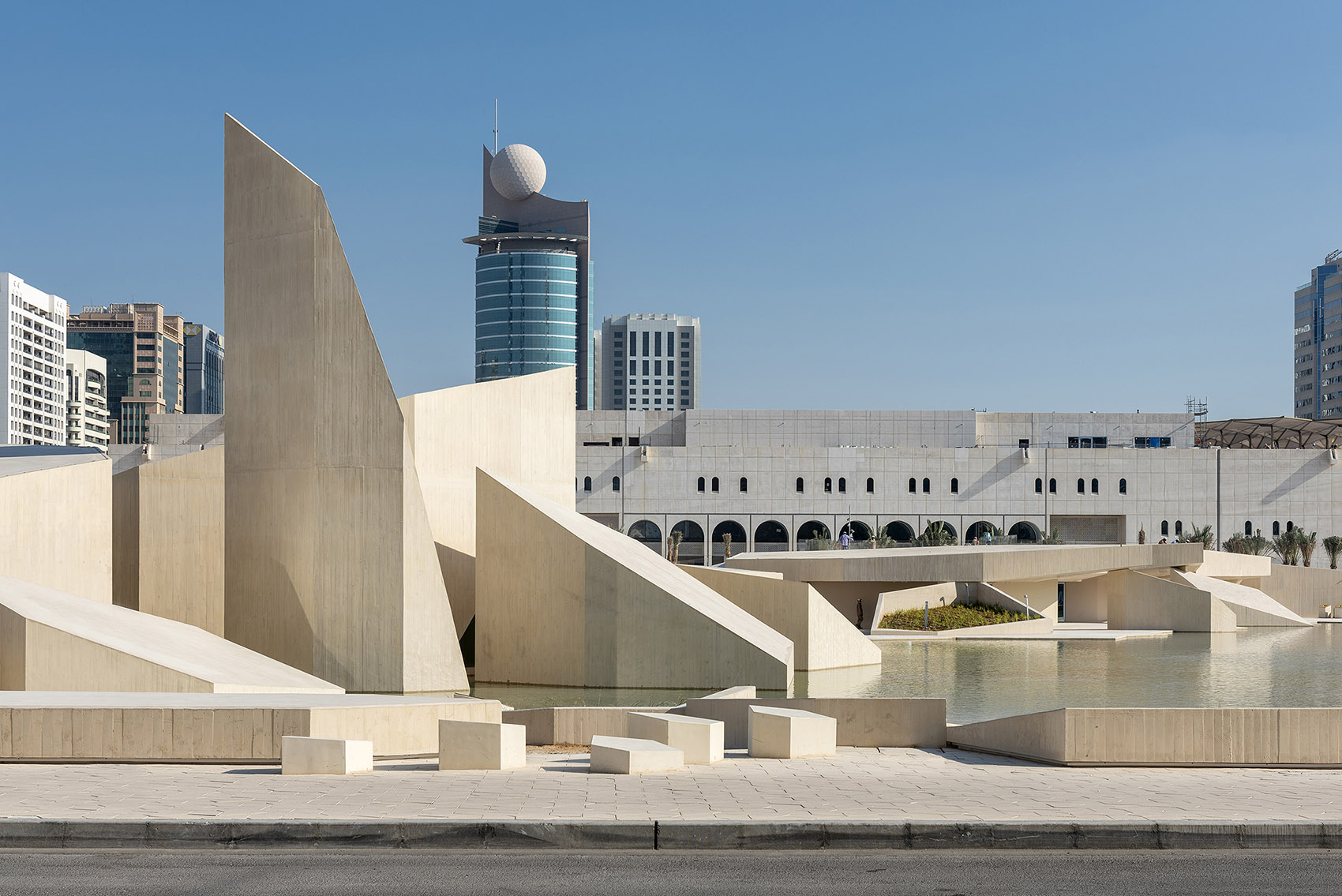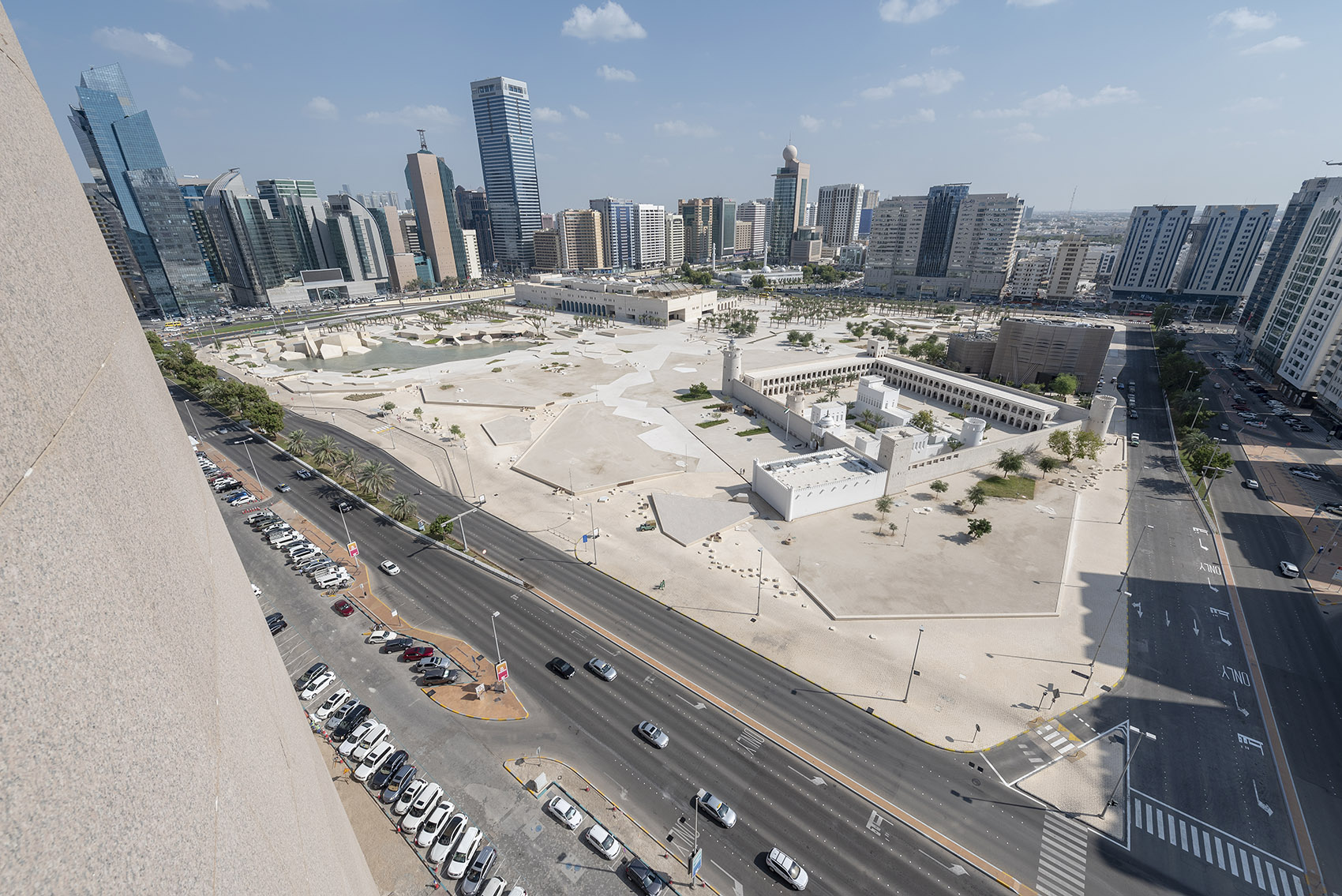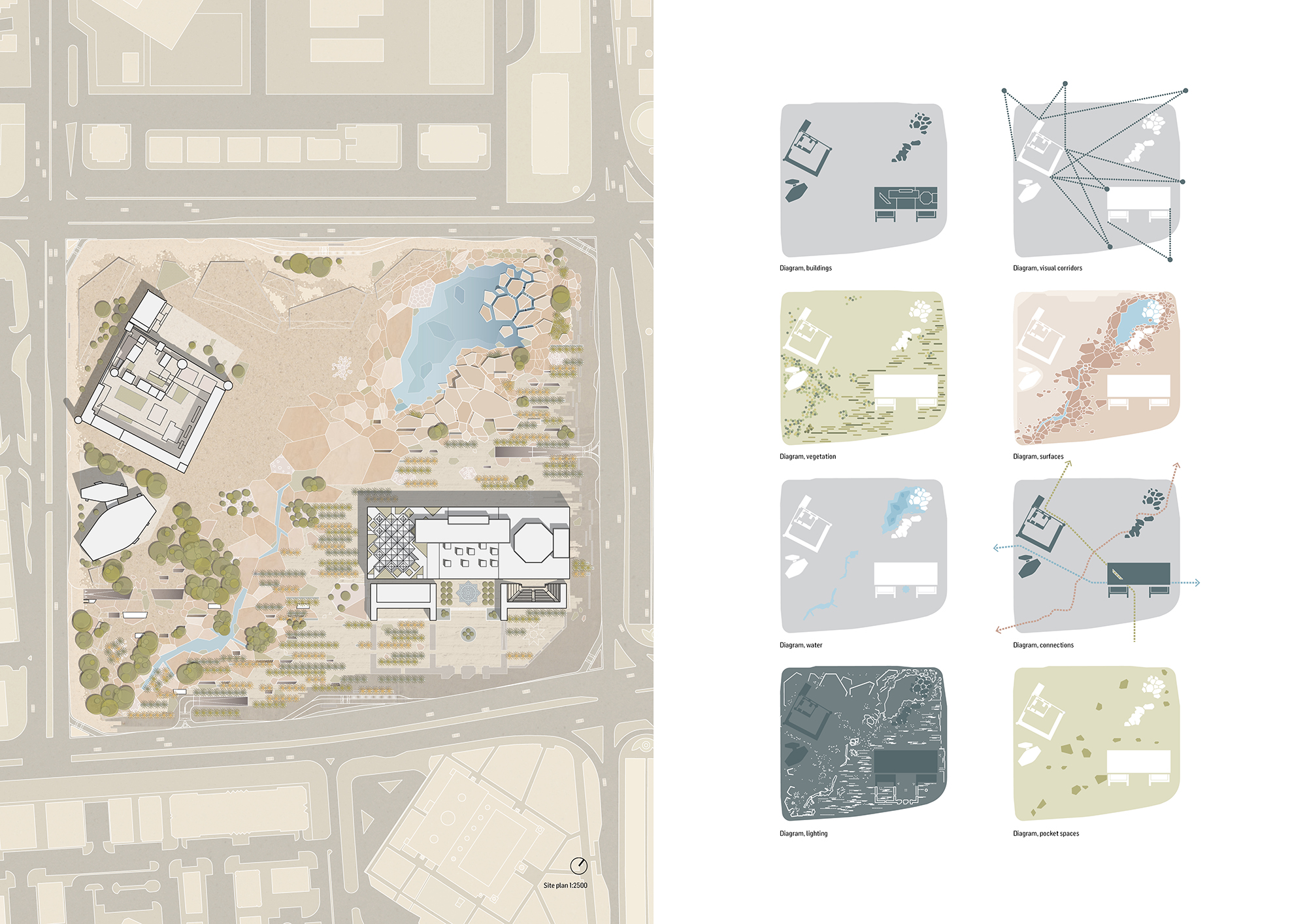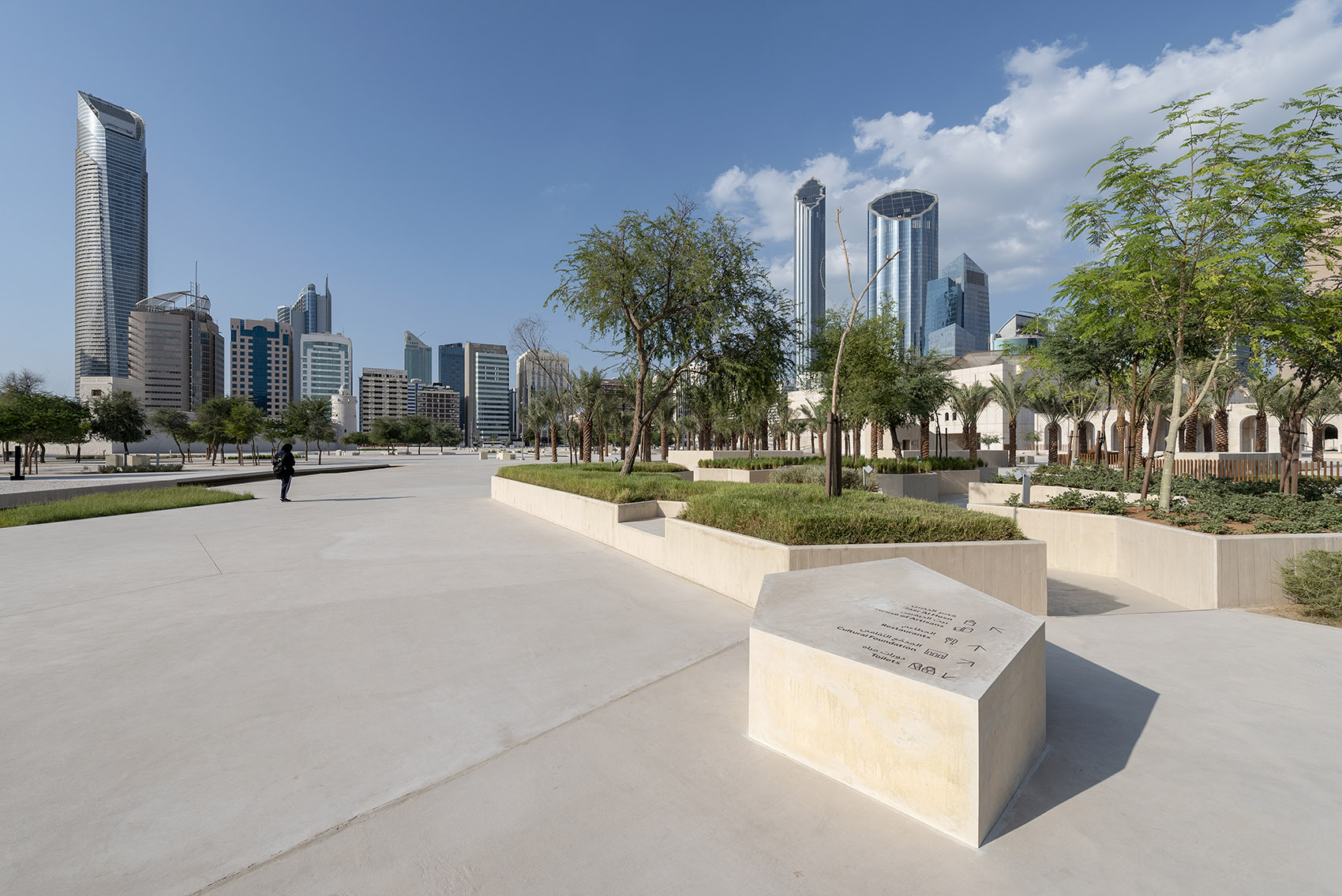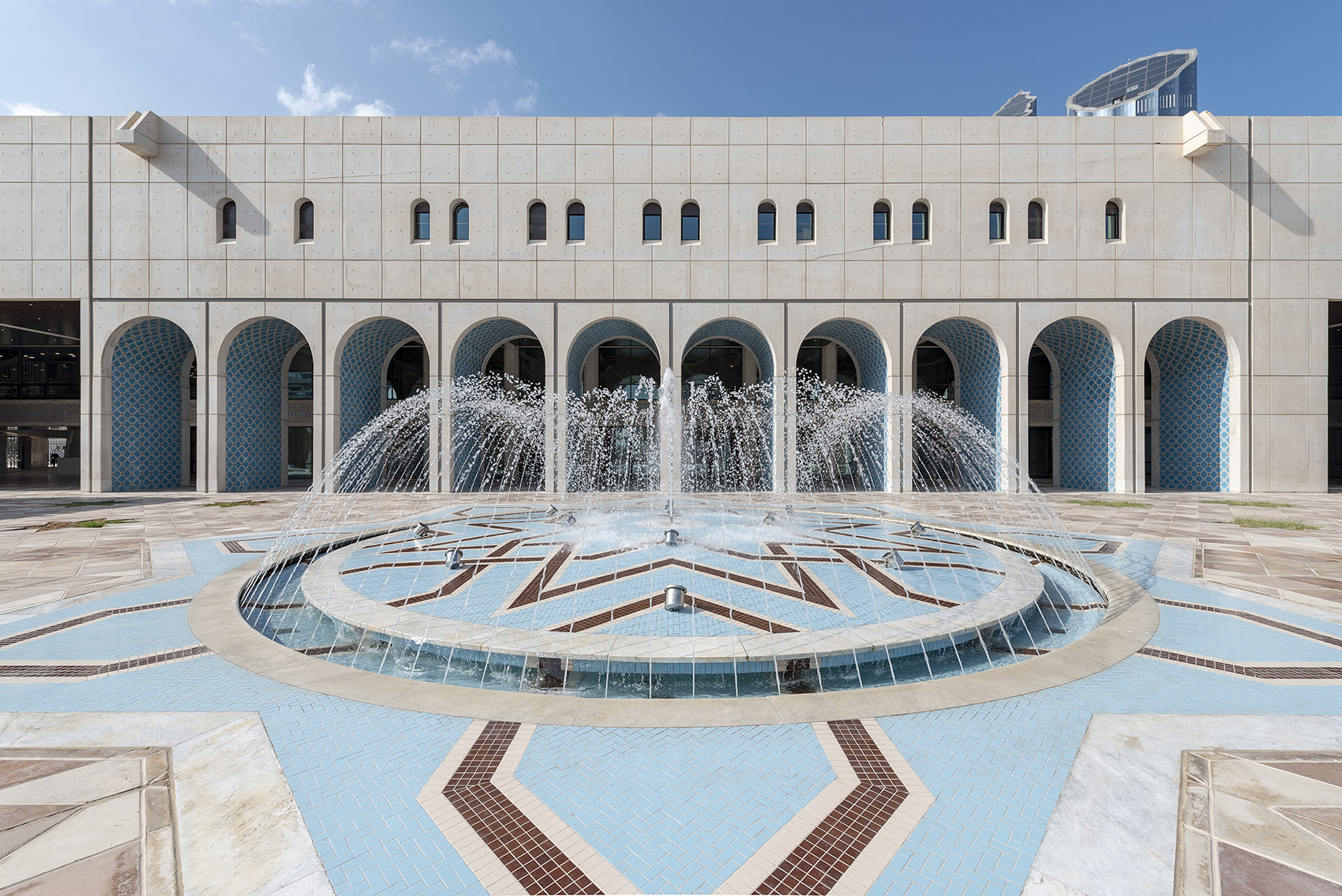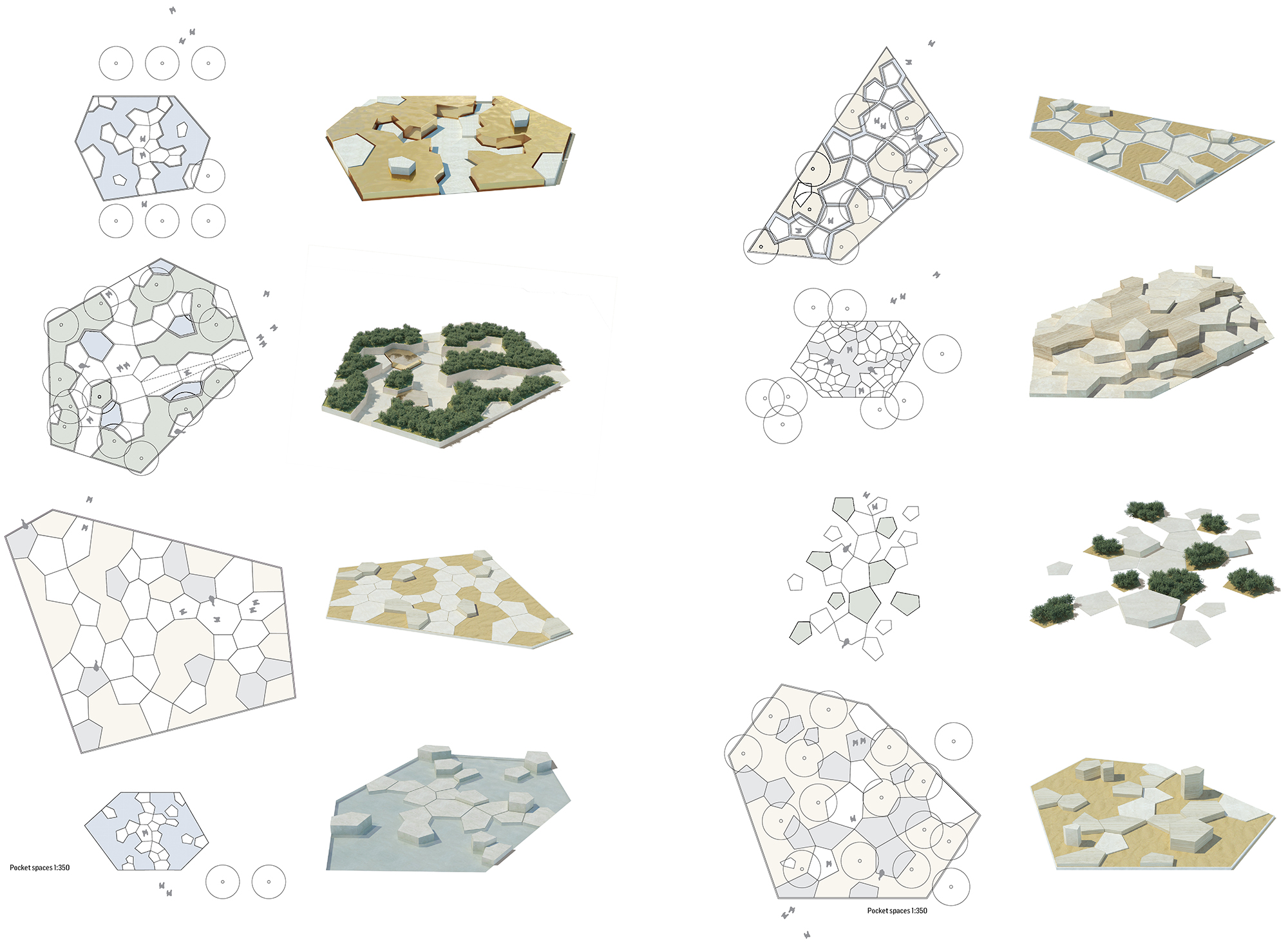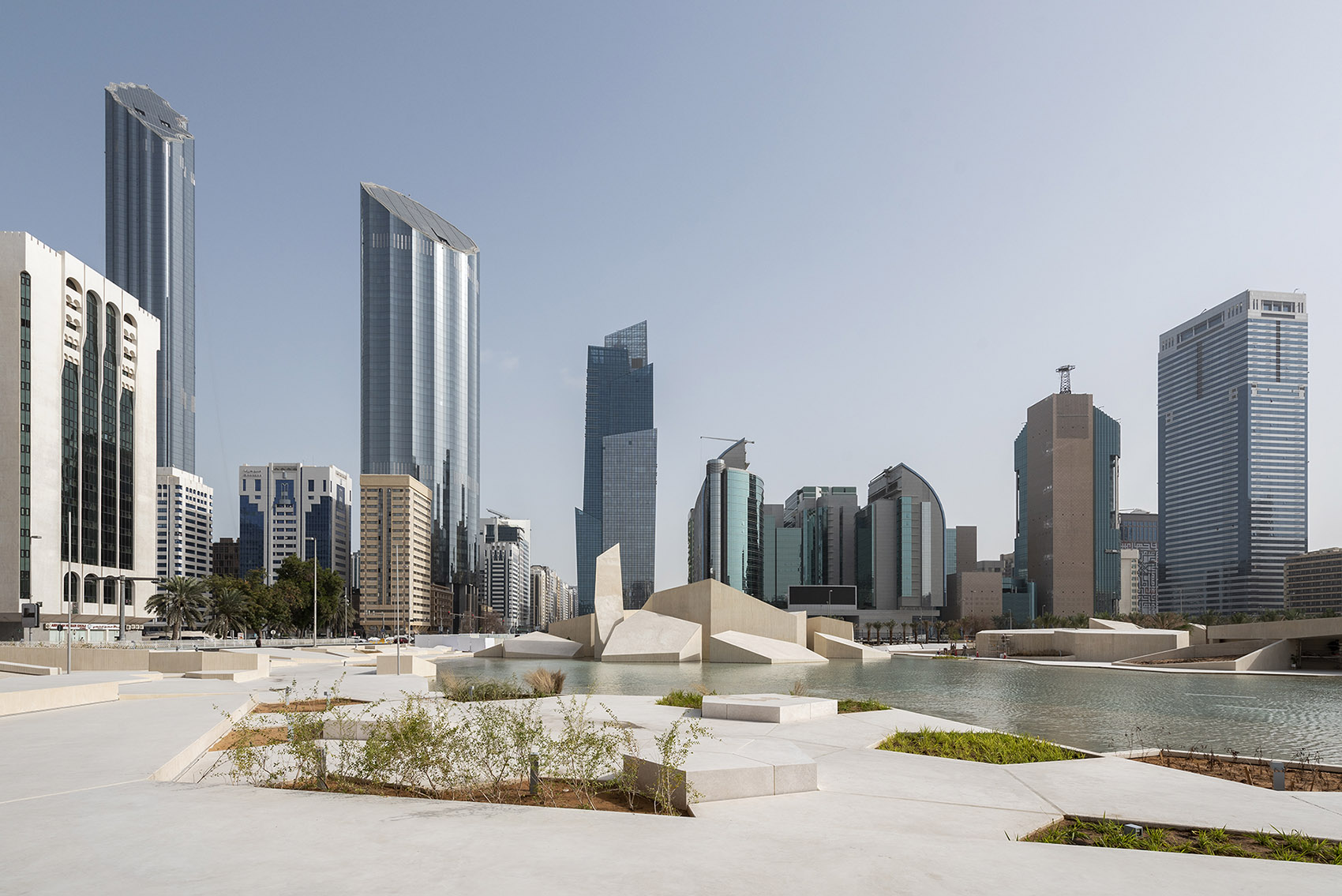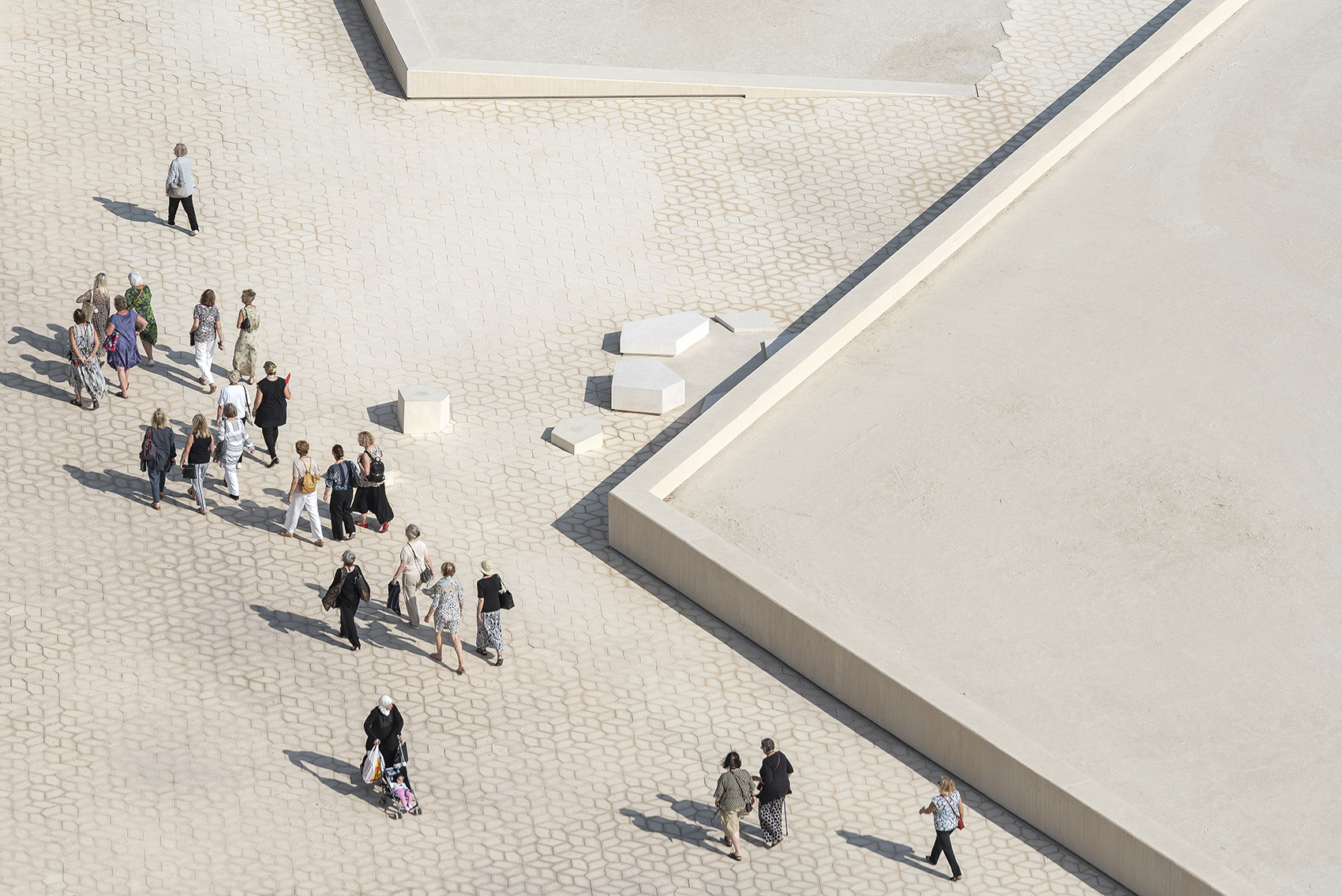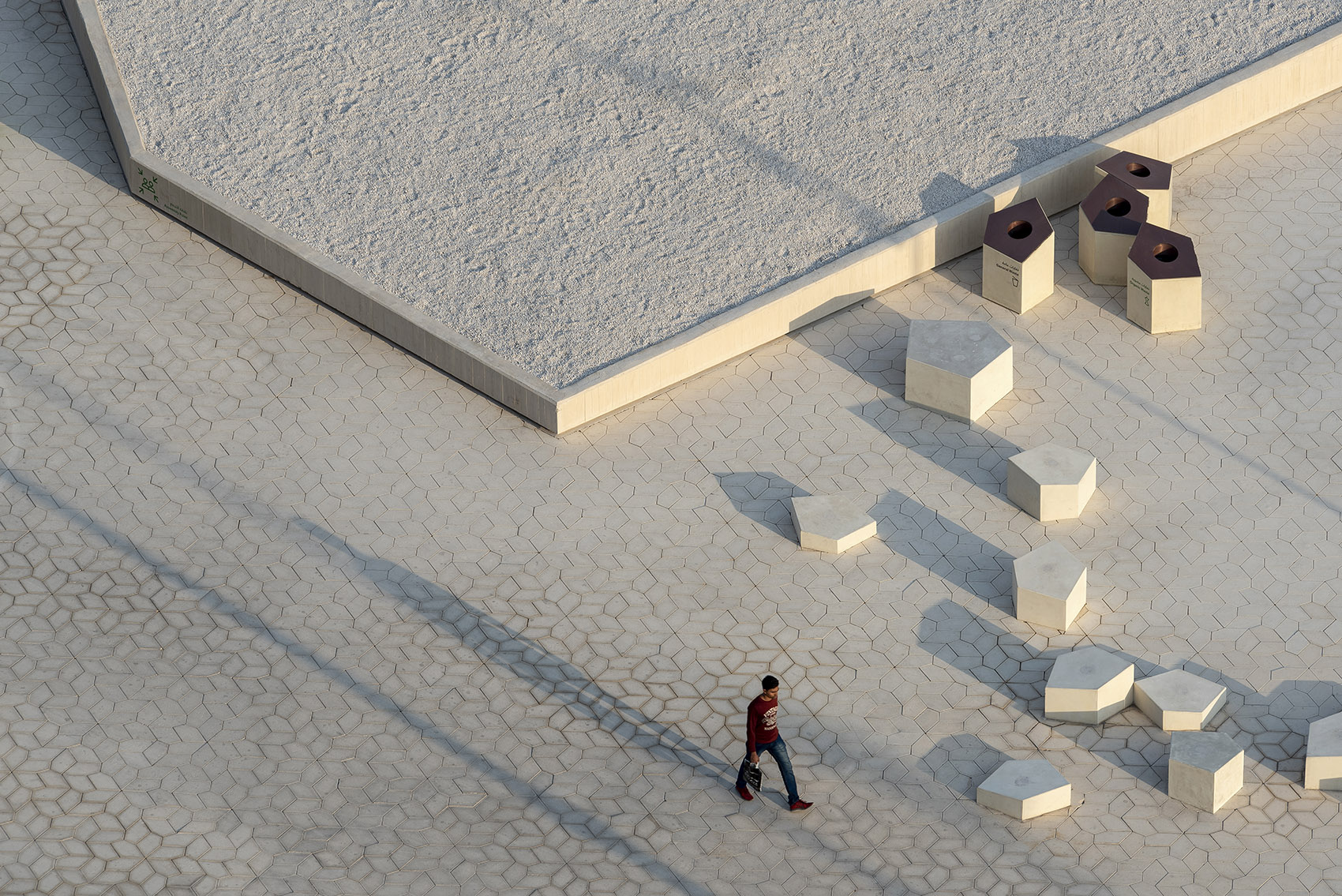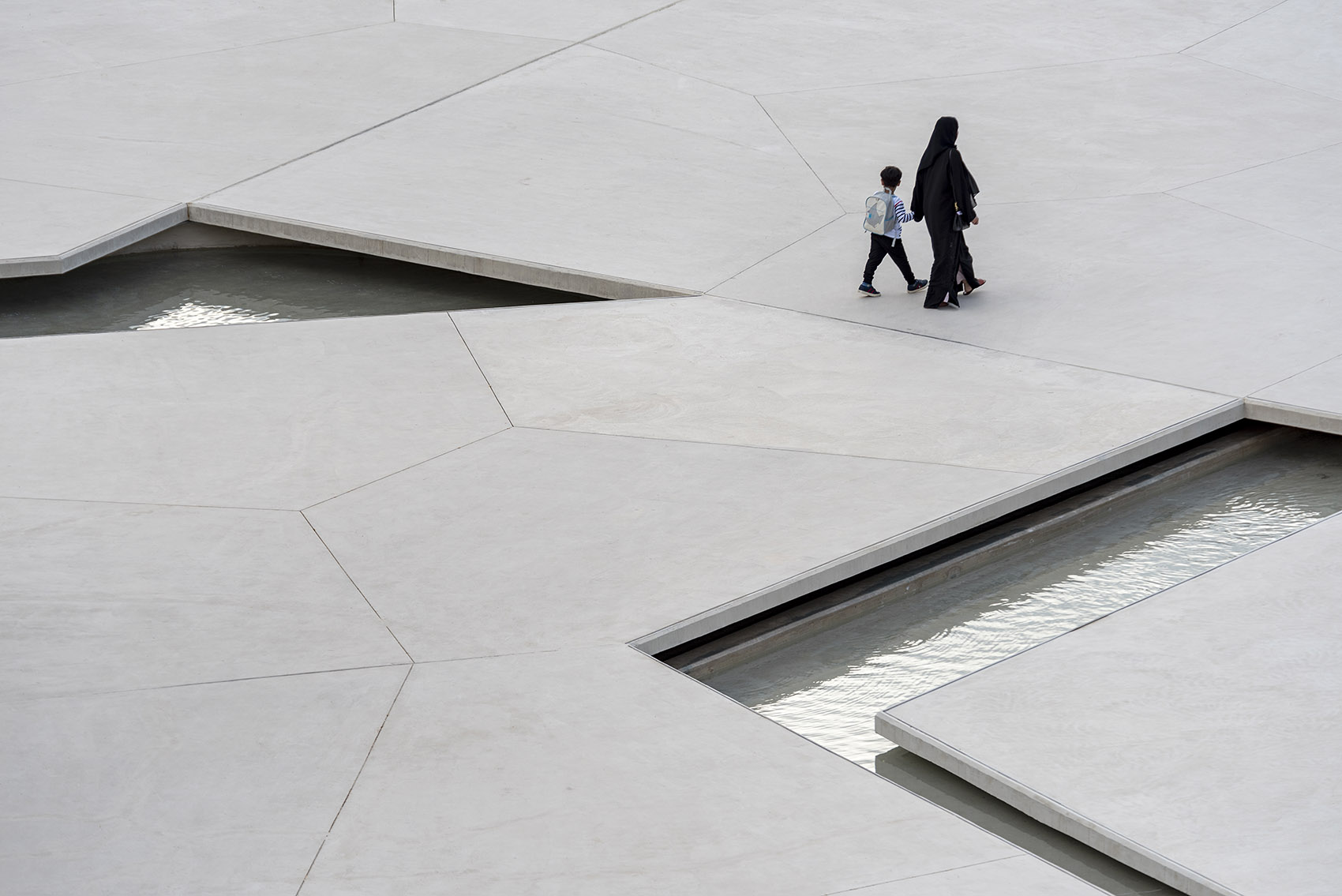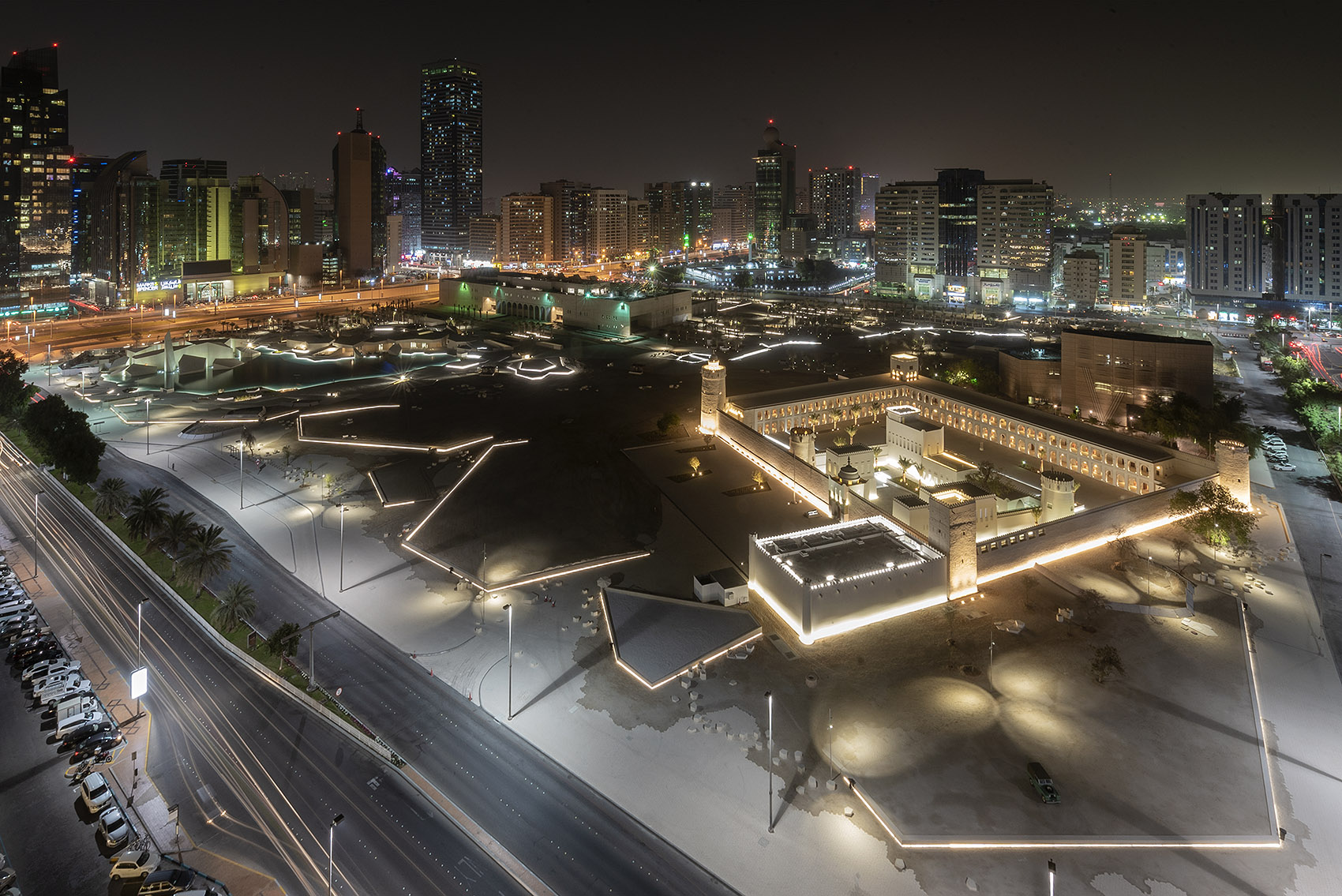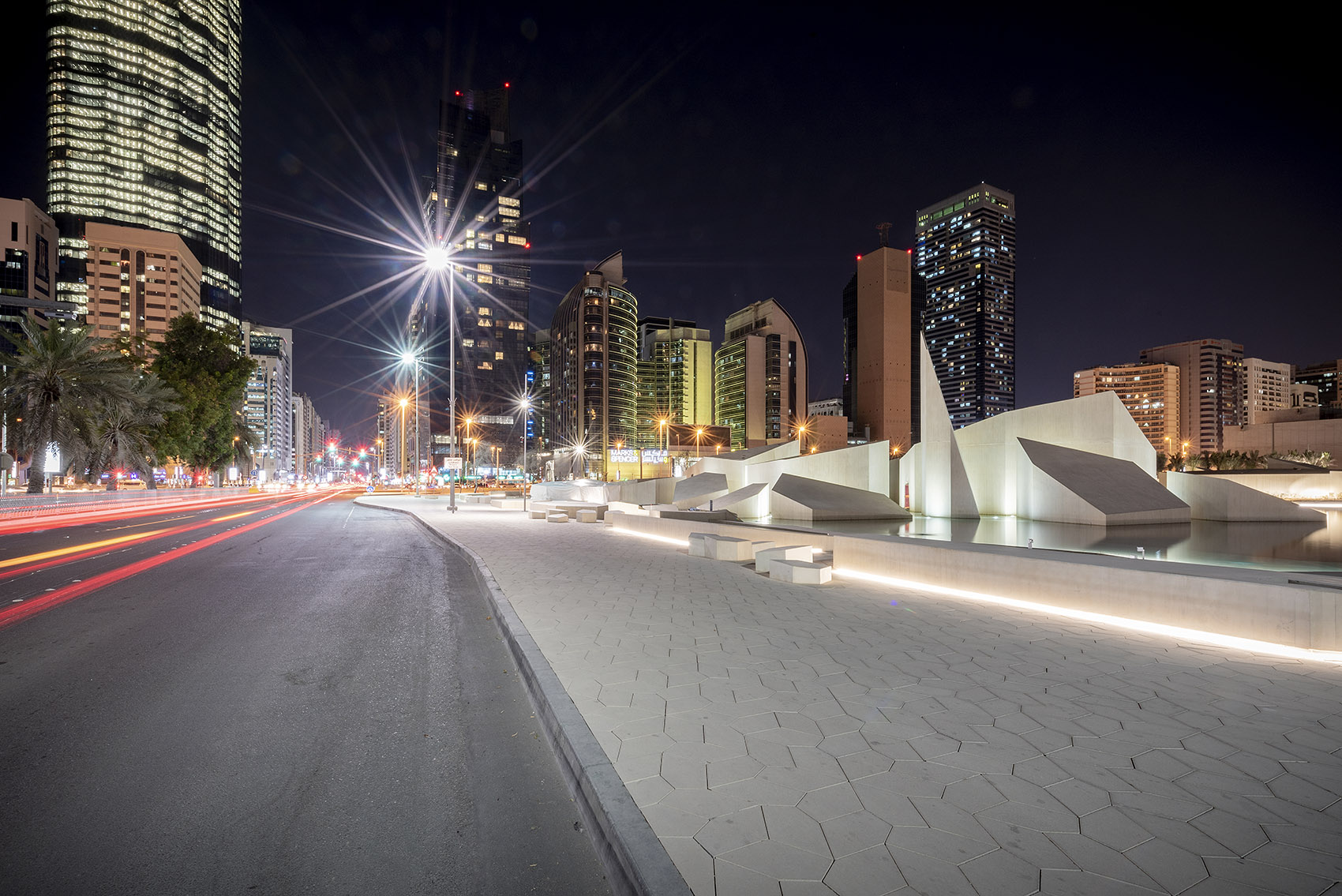2016年,丹麦建筑和设计公司CEBRA受到阿布扎比文化和旅游部门的委托,重新设计并恢复豪森宫殿作为阿布扎比文化心脏的地位。豪森宫殿是该城市最古老也最为重要的建筑。其最初建于1760年,是一座用来守护阿布扎比岛上唯一一口淡水井瞭望塔,后来被扩建为宫殿,是这座现代都市真正的发源地。
In 2016 the Danish architecture and design practice CEBRA was commissioned by the Department of Culture and Tourism Abu Dhabi to reinstate the Qasr al Hosn Fort as Abu Dhabi’s cultural heart. The Qasr Al Hosn is the city’s oldest and most important building. Originally built in 1760 as a watchtower to protect the only freshwater well on Abu Dhabi Island and later extended into a palace, it literally constitutes the birthplace of the modern metropolis.
▼景观概览,overall view of the landscape ©Mikkel Frost
项目旨在恢复城堡的文化核心地位。为此,总体规划增加了14万平米新的文化公园景观,保护城堡周边地块以及同处基地上的城市文化基金会,后者是一栋体现包豪斯起源的文化中心,于1980年被列入保护名册。通过引入植根当地的新型城市景观,项目将现代性与阿联酋的海事和沙漠遗迹结合在一起,以一致的叙事在基地上两栋对比强烈的建筑之间形成对话。
The aim of the transformation masterplan has been to reinstate the fort as the cultural heart of the city with a new 140.000 sqm cultural park-scape and to conserve both the site surrounding the fort and the city’s Cultural Foundation – a 1980’s listed cultural centre of Bauhaus origins – which also sits on the site. Introducing a new type of locally rooted urban landscape the project combines modernity alongside the Emirate’s maritime and desert heritage in a coherent narrative that communicates between the site’s two contrasting buildings.
▼鸟瞰,aerial view ©Mikkel Frost
如今,基地被改造成了一座充满活力的公共公园,加强了两栋历史建筑作为城市地标的重要性。与此同时,项目为豪森宫殿增添了一些新的功能,使其成为阿布扎比整个城市的财产。这些功能包括餐厅,文化活动设施,一间令人惊叹的祷告厅,以及一片引人入胜的开放景观,设有水景和阴凉的口袋空间,为人们提供了中东烈日下的休闲场所。
Today the site is transformed into a vivid public park, which enhances the two historic buildings as important landmarks in the city. Simultaneously, the project adds several new functions to the Al Hosn site making it an asset to the entire city of Abu Dhabi – restaurants, facilities for cultural activities, a breath-taking prayer hall, and an impressive open landscape with water features and shady pocket spaces for relaxation in the Middle Eastern sun.
▼设计分析,design analysis ©CEBRA
项目沿对角线分成了两片截然不同的景观区域,强调了自身的两面性。豪森宫殿周边景观开放平坦,如沙漠一般,唤起了这座宫殿在现代城市快速发展之前独自矗立于沙地之上的地标形象。与此相反,围绕文化基金会建筑的景观中设有地砖铺砌的功能区域,其间点缀植物,将沙漠景观与现代城市网格结构连接在一起。
The project emphasizes its own duality by dividing the site diagonally into two contrasting landscapes. A plain and open desert-like landscape around the Qasr Al Hosn Fort reinstates the building as a free-standing landmark on sand like it was before the modern city rapidly sprung up. Opposite, a paved and programmed area with intensified planting surrounds the Cultural Foundation Building, thus combining the desert landscape with the modern city grid structure.
▼城堡周围景观平坦,plain landscape around the Fort ©Mikkel Frost
▼从基金会周边的景观看向城市 view to the city from the landscape area surrounding the Foundation ©Mikkel Frost
▼文化基金会外的景观铺地和喷泉 landscape paving and fountain outside the Cultural Foundation ©Mikkel Frost
▼从文化基金会屋顶看向城市街道 view to the urban street from the roof of the Cultural Foundation ©Mikkel Frost
两处景观通过一片城市公共空间相连。该空间的灵感来自于“裂缝”的形成,呈现出不规则的几何形状。中央景观区域中的有机图案由泰森多边形法确定。设计以建筑的方式诠释阿布扎比岛海岸景观中的沙洲、红树林、以及盐滩上独特的裂缝图案,在当下的都市中心和作为其发源的自然环境之间建立起连接。
▼景观生成,generation of the landscape ©CEBRA
The two landscapes are connected by a public urban space emerging from formations of ”cracks” and irregular geometric shapes. The central landscape area is defined through an organic pattern known as a ‘Voronoi’. The design articulates an architectural interpretation of Abu Dhabi Island’s coastal landscape of sandbars, mangroves, and the salt flats’ distinctive cracked patterns, drawing connections between the centre of today’s metropolis and the natural setting from which it emerged.
▼不规则几何图案组成的城市公共空间 urban public space composed of irregular geometric patterns ©Mikkel Frost
该城市景观的几何形式在设计上有意呈现了一种介于建筑和景观之间的特性,采用与自然沙地颜色一致的混凝土建造。在过渡区域中,景观从平面变为倾斜的表面,并逐渐成长为实际的建筑,容纳餐厅设施和辅助空间,最终在基地东北角的Musallah祷告厅达到高潮。
The geometries of the urban landscape intentionally land somewhere between building and landscape, with the tone of the concrete matching the colour of the natural sand. Along the transitional zone, the landscape changes from horizontal planes to slanting surfaces that gradually grow into actual buildings for food and beverage facilities, ancillary functions, and culminating with a Musallah prayer hall at the north-eastern corner of the site.
▼景观从平面过渡成建筑 landscape gradually grows from horizontal plates to buildings ©Mikkel Frost
▼倾斜的表面近景,closer view to the slanting surfaces ©Mikkel Frost
项目中的所有构件,从座椅、表面图案、灯光概念、建筑体量,到室内的楼层平面、门厅和家具,都巧妙的整合在了城市景观的地形之中,与公园融为一体,给人以自然景观元素一般的体验。借此,城堡和文化基金会得到强调,成为景观中的主要视觉焦点。
All components – from sitting bollards, surface patterns, lighting concept, and building volumes to the interior’s floor plans, doorways, and furnishings – are subtly integrated into the overall urban landscape topography and merge with the park to be experienced as natural landscape elements. Thus, the landscape emphasises the Fort and the Cultural Foundation as the main visual anchors.
▼与景观整合的城市家具,urban furniture integrated into the landscape ©Mikkel Frost
在豪森宫殿景观设计中,水成为了自然的关注点,其既具备文化的重要性,作为整合元素被运用在整体设计叙事中;又是项目微气候里的天然降温元素,并为最小化公共公园内的用水量提供了解决方案,如种植本地的耐旱植物以及用当地产生的家庭污水灌溉等。公园的中部区域设有一系列从南向北流淌的水景,在独特的不规则几何铺地中形成窄湾、运河、小溪以及地下水道,在Musallah祷告厅周围汇聚成一片宽广的水池。
Water constitutes a natural focal point in the design of the Al Hosn landscape – both for its cultural significance, as an integrated element in the overall design narrative, as a natural cooling element for the project’s microclimate, and to present solutions for minimizing water consumption within the public park – i.e., by using native desert plants with low water consumption and to use grey wastewater from the local area when watering the park. The park-scape’s central zone integrates a series of water features that run from south to north, breaking out of the distinctive pavement’s irregular geometries as narrow creeks, canals, streams, and underground passages that transform into large water feature around the Musallah prayer hall.
▼不规则图案间的小溪,creeks flowing through the irregular patterns ©Mikkel Frost
设计没有采用传统公园中的茂盛植被,因为在沙漠气候中对植物进行全面灌溉和养护十分困难。项目希望通过使用当地材料和本地生长的需水量很小的耐旱植物,创造一座体现当地美学特征的公园,
Instead of landscaping a traditional urban park of lush vegetation that would require comprehensive irrigation and maintenance in a desert climate, the project aims at creating a locally anchored park aesthetic characterized by the use of local materials and indigenous, hardy, sun tolerant plants that require minimal irrigation.
▼祷告厅外的水池和耐旱植物 water pool around the prayer hall and the hardy plants ©Mikkel Frost
豪森宫殿景观项目通过交织的路径连接基地、临近的功能设施以及更大的城市网格,为城市创造了一条重要的流线,提升步行环境,成为了公共生活的发电机。公园中的植被为人们提供了沿途的遮阳和口袋空间,使得上述公共功能得以实现。此外,景观倾斜表面形成的巨大悬挑组成了水景边的餐饮建筑,为室外活动创造了无需人工空调的舒适气候环境。
The Al Hosn site introduces a meaningful flow through the city by interweaving paths across the site with the adjacent functions and the wider urban fabric, thereby promoting pedestrianism and acting as a dynamo for public life. This is supported by the park’s vegetation, which provides shade along the pathways and pocket spaces. Also, large overhangs created by the landscape’s slanting surfaces form the food and beverage buildings along with the water feature, which supports a comfortable climate for outdoor activities independent from artificial air-conditioning.
▼水池夜景,view of the pool in the night ©Mikkel Frost
设计师与阿布扎比文化和旅游部门紧密合作,共同完成了本次项目的开发。豪森宫殿总体规划项目在过去几年间获得了数项国际建筑大奖,最近获得的奖项为2021年的WAN奖和WAF奖,表彰项目在总体规划和景观建筑设计上的成就。
The project is developed in close collaboration with The Department of Culture and Tourism – Abu Dhabi (DCT Abu Dhabi) The Al Hosn masterplan project in Abu Dhabi, designed and developed by Danish CEBRA, has received several international architecture awards over the last few years – most recently the project has been awarded both WAN Award 2021 and WAF Award 2021 for its overall masterplan design and landscape architecture.
▼业绩高鸟瞰,aerial view in the night ©Mikkel Frost
▼夜晚从城市街道看向祷告厅 view to the prayer hall from the urban street in the night ©Mikkel Frost
▼总平面图,master plan ©CEBRA
Location: Abu Dhabi, UAE Client: Department of Culture and Tourism – Abu Dhabi (DCT Abu Dhabi) Size: 140.000 M² Status: Completed Architect: CEBRA Landscape architect: CEBRA Plant Specialist: SLA Engineer: GHD Conservation specialist: Elgaard Architecture Signage and wayfinding: Kossmann.Dejong

